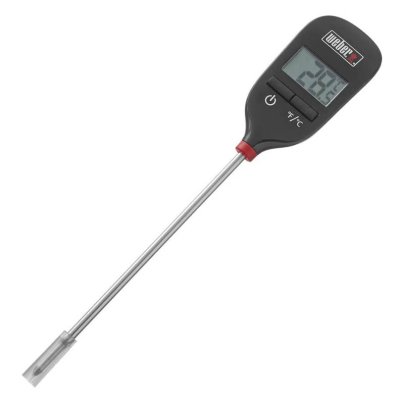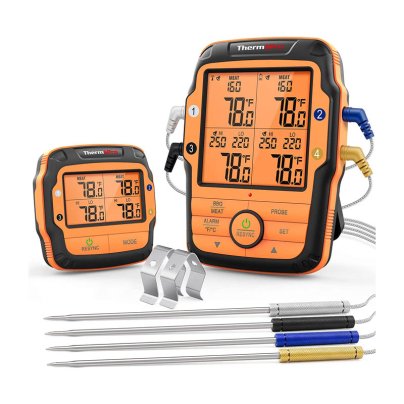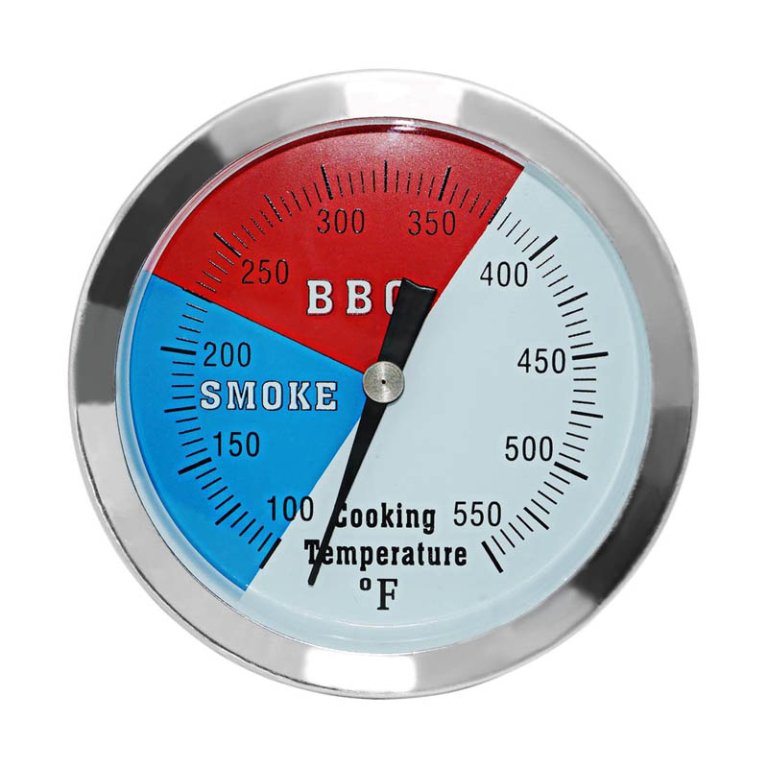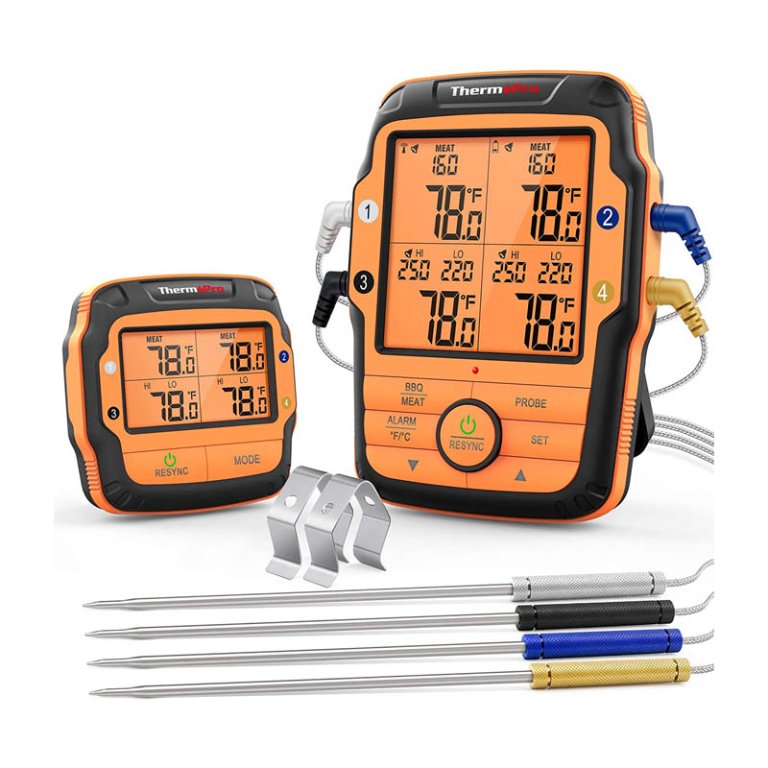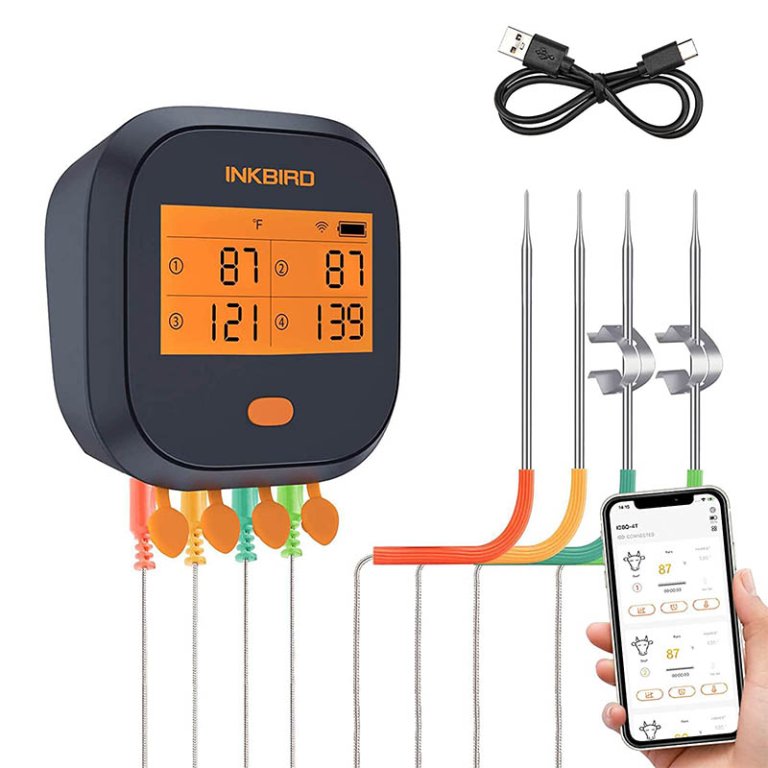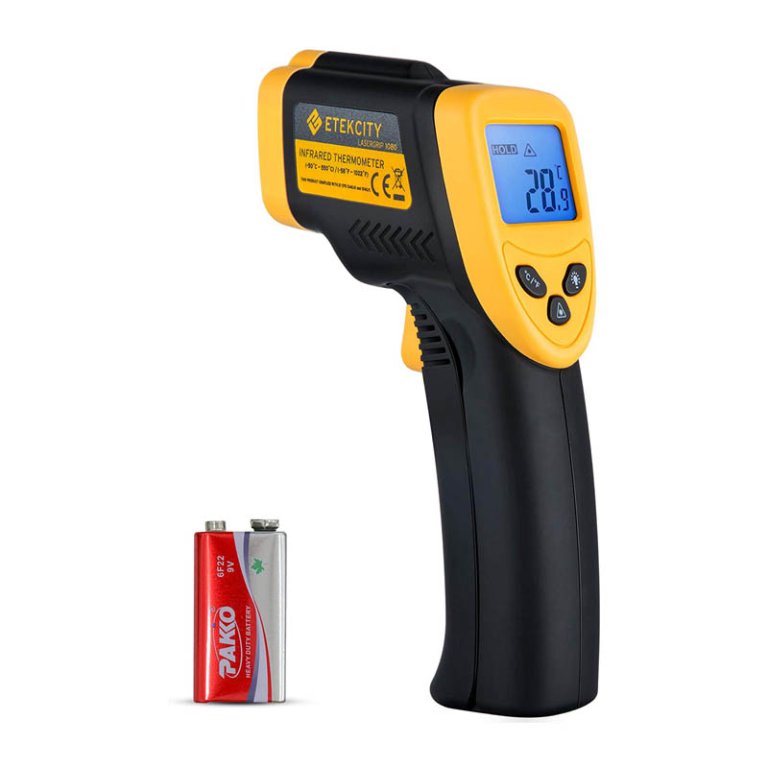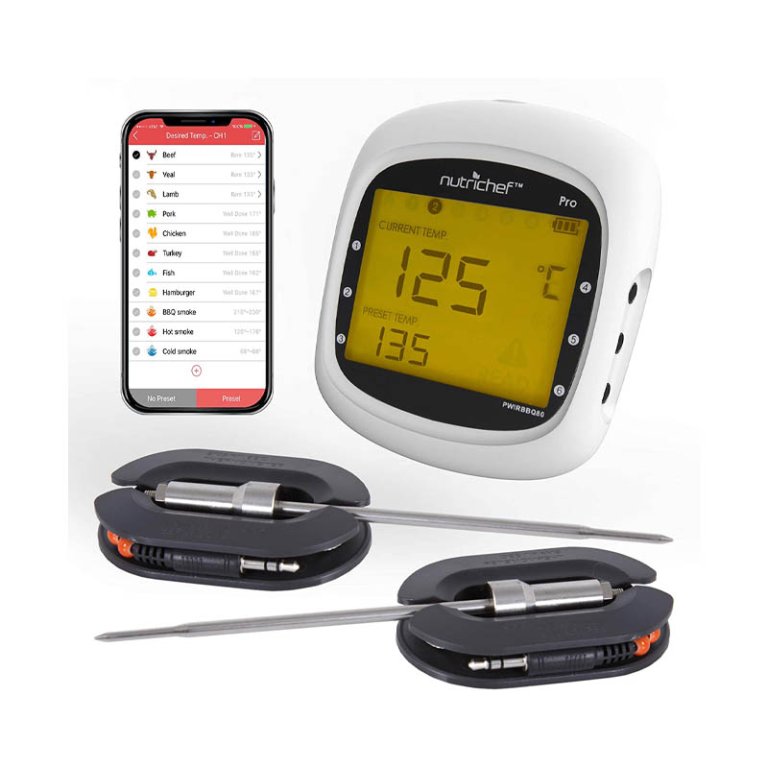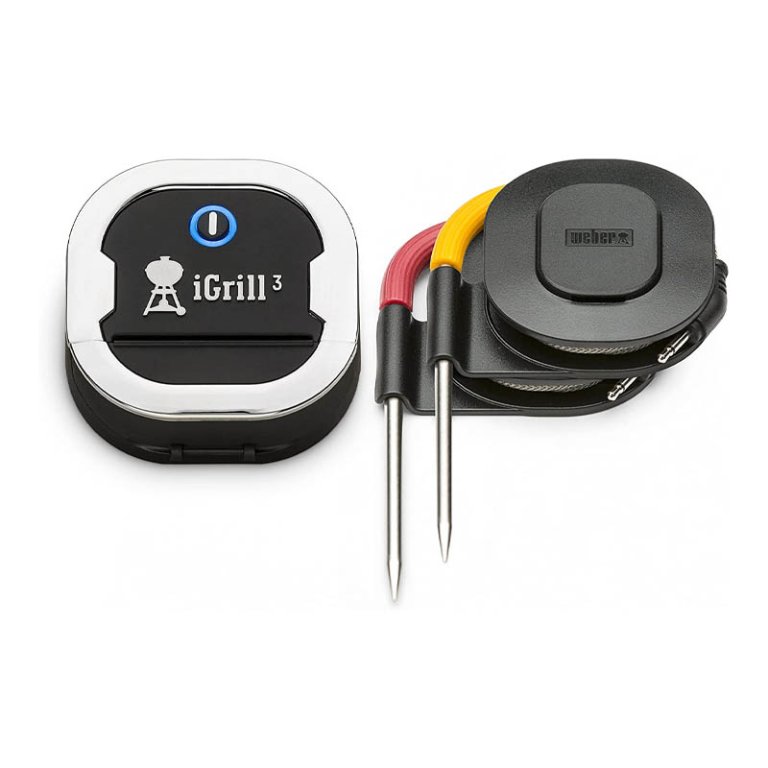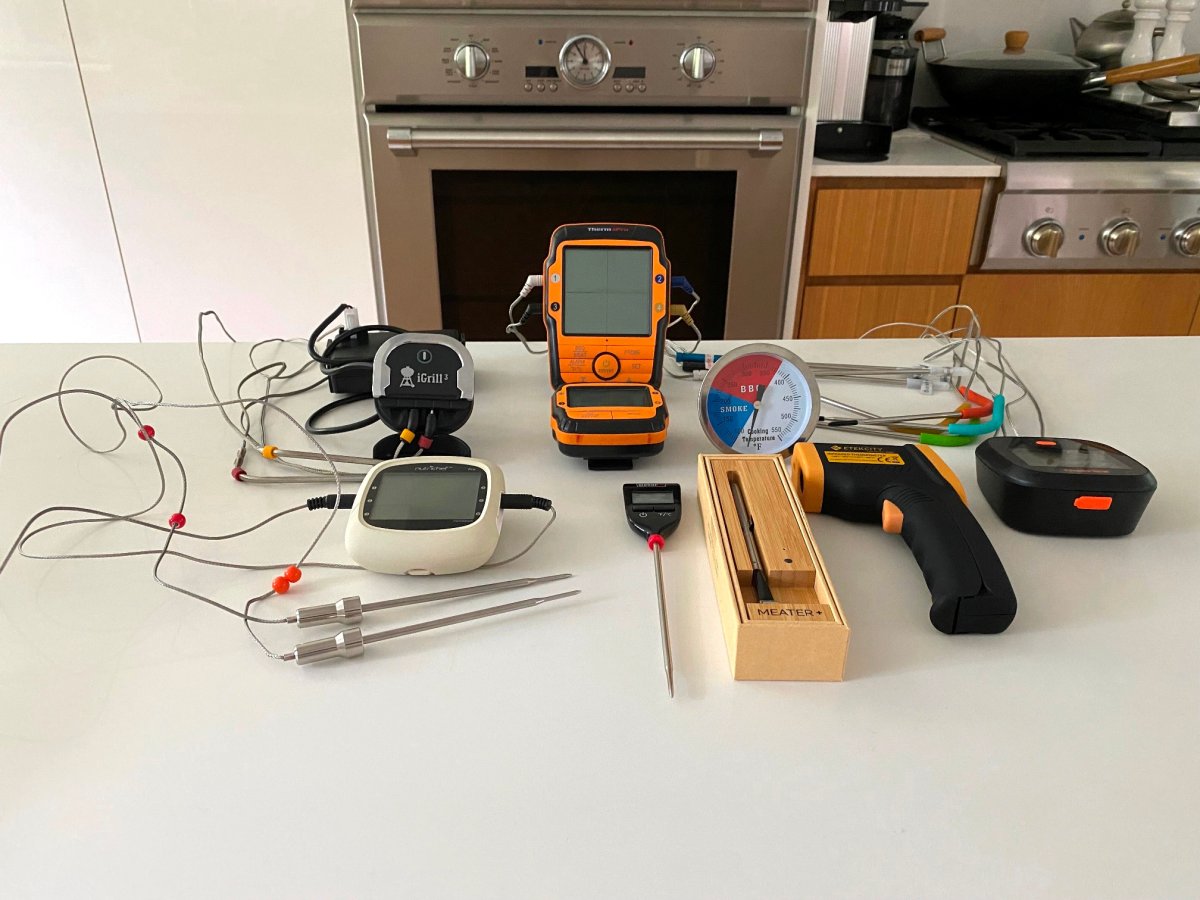
We may earn revenue from the products available on this page and participate in affiliate programs. Learn More ›
Depending on what you’re cooking, a grill thermometer can mean the difference between a perfect medium-rare steak and an overdone, chewy mess. Grill thermometers are available in a range of types that are used for various temperature readings, including the current temperature of the grill or smoker, the external temperature of your food or a hot plate, and the internal temperature of the food itself. Plus, some grill thermometers even connect via Wi-Fi or Bluetooth to provide instant readings and alerts to your smart device.
Due to this range of applications, the best grill thermometer for your next outdoor living barbecue or tailgate party may actually be a combination of two or three different thermometers.
As we did with meat thermometers, we tested these thermometers using both a grill and a smoker on a range of food, including meat, poultry, and fish. We experimented with cooking different cuts and types of meat, trying them on bone-in, boneless, ground beef, and poultry, as well as whole fish and fish fillets. Finally, we also tested them in all kinds of weather and light to gauge the responses of the thermometers in real-world conditions. Our top pick, the Dozyant 3 1/8 inch Charcoal Grill Temperature Gauge, is accurate and easy to use for intermediate grillers.
Keep reading to learn more about the different features, considering the realities of how and where you most often use your grill and/or smoker, and take a look below to check out some of the best grill thermometers for your purposes.
- BEST OVERALL: Dozyant 3 1/8 inch Charcoal Grill Temperature Gauge
- BEST BANG FOR THE BUCK: Weber 6750 Instant Read Meat Thermometer
- BEST WIRELESS: ThermoPro TP27 Long Range Wireless Meat Thermometer
- BEST WI-FI: Inkbird IBBQ-4T WiFi Grill Meat Thermometer
- BEST LASER: Etekcity Infrared Thermometer Non-Contact Digital Gun
- BEST FOR SMOKING: NutriChef Wireless Bluetooth BBQ Digital Thermometer
- BEST DESIGN: Meater Plus Smart Wireless Meat Thermometer
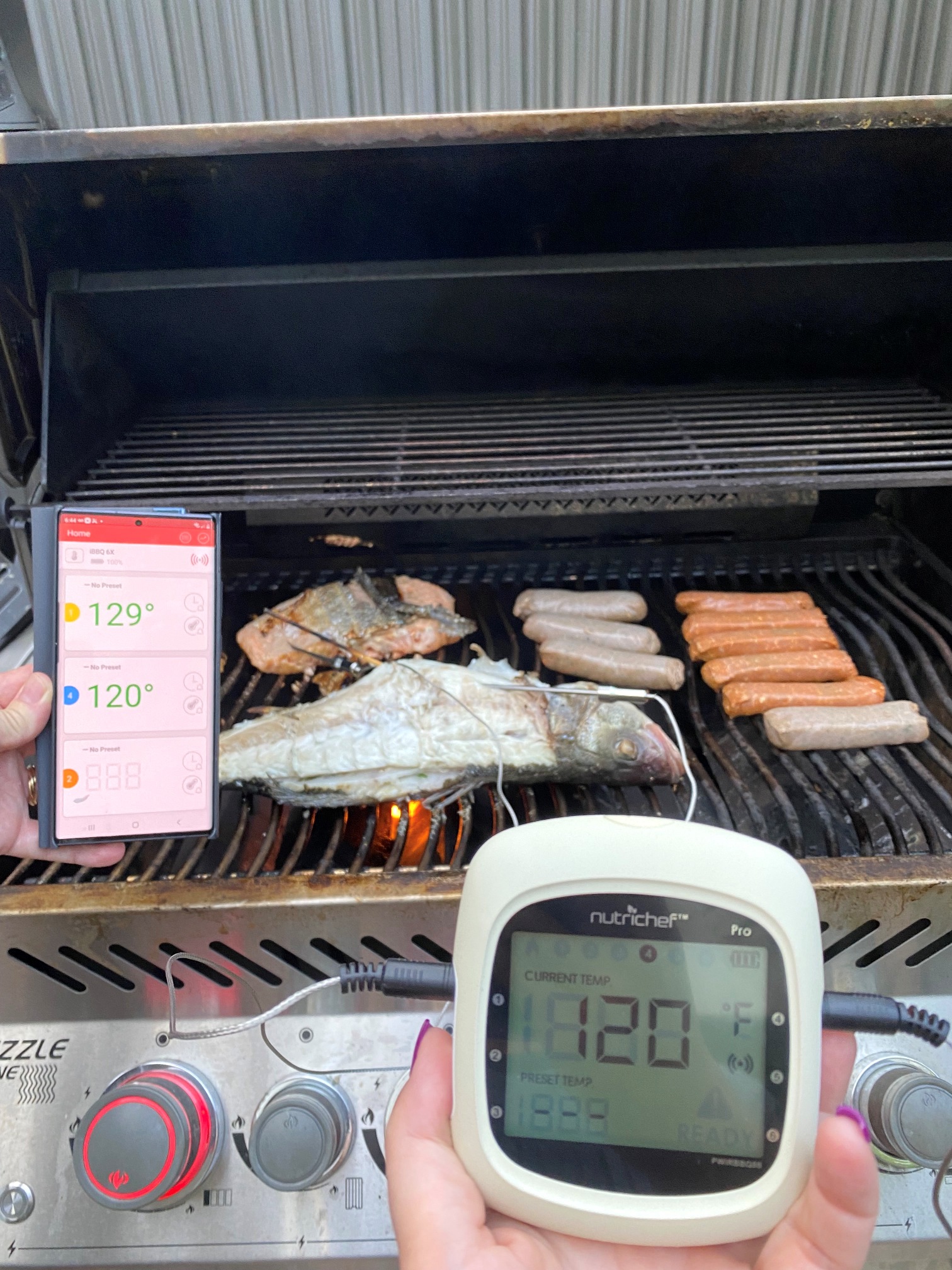
| Difficulty Level | Materials | Charging Needs | |
| Dozyant 3 1/8 inch Charcoal Grill Temperature Gauge | Intermediate | Stainless steel and glass | None |
| Weber 6750 Instant Read Meat Thermometer | Beginner | Plastic casing and metal probe | 1 CR2032 battery |
| ThermoPro TP27 Long Range Wireless Meat Thermometer | Advanced | Plastic, rubber, and stainless steel mesh wire and probes | 4 AAA batteries |
| Inkbird IBBQ-4T WiFi Grill Meat Thermometer | Expert | Plastic, magnetic back, stainless steel probes with colored rubber coating | Rechargeable lithium battery |
| Etekcity Infrared Thermometer Non-Contact Digital Gun | Beginner | Plastic | One 9-volt battery |
| NutriChef Wireless Bluetooth BBQ Digital Thermometer | Advanced | Plastic and stainless steel | 2 AAA batteries |
| Meater Plus Smart Wireless Meat Thermometer | Advanced | Metal and wood | 1 AAA battery |
Our Top Picks
To find the best grill thermometers, we road-tested some of the most popular models and evaluated their performance on a variety of foods in real-world circumstances, during all types of weather and light conditions and with family and pets around. We considered quality, price, and overall efficacy. We also thought about where you might be grilling: indoors, in the backyard for family cookouts, on camping trips, or even on an apartment balcony. Everyone has their own grilling style and capabilities, and choosing a thermometer or two should reflect your needs, not just your desires.
Best Overall
Dozyant 3 1/8 inch Charcoal Grill Temperature Gauge
What We Like
- Color-coded dial is easy to see; suitable for professionals as well as DIYers
- Provides consistent results and usage for a long time
- Solid stainless steel case provides long-term longevity and an attractive finish
What We Don’t Like
- Dial fogs up with moisture
- Not as easy to read in low-light conditions
- Does not fit on all smokers/grills
Product Specs
- Difficulty level: Intermediate
- Materials: Stainless steel and glass
- Charging needs: None
Grill-top grill thermometers are typically included with the grill, but unfortunately, these products can be inaccurate. For a more accurate measurement (within ±2 percent), this Dozyant grill-top grill thermometer can be installed on an oven, grill, or smoker. The thermometer has a long 3-inch stem that extends into the interior of the grill to read the ambient temperature.
The face of the grill thermometer is 3.125 inches across and has a solid stainless steel case to protect the dial from damage. This thermometer measures in a range from 100 to 550 degrees Fahrenheit, and it features a cool blue zone between 100 and 225 degrees Fahrenheit for smoking and a warm red zone between 225 and 375 degrees Fahrenheit for grilling. The surface of the dial is waterproof and made with no-fog glass to ensure clarity in any weather.
However, in very wet climates, moisture can occasionally seep in and fog up the glass. Plus, not all grills or smokers include a hole for inserting an ambient thermometer. Before purchasing this thermometer, check that the grill has a hole.
Get the Dozyant temperature gauge at Amazon.
Best Bang for the Buck
Weber 6750 Instant Read Meat Thermometer
What We Like
- Great temperature range; can measure from 32 to 446 degrees Fahrenheit
- Minimal learning curve needed for reading this thermometer
- Easy to clean construction will last for years to come
What We Don’t Like
- Small enough to misplace in a drawer or kit
- Allows hands to get too close to cooking surface
- Curved, slippery casing may not be ideal for some users
Product Specs
- Difficulty level: Beginner
- Materials: Plastic casing and metal probe
- Charging needs: 1 CR2032 battery
Sometimes the features of a complex thermometer can be unnecessary if all that’s needed is a simple internal temperature reading like the affordable Weber Instant Read Meat Thermometer offers in either Fahrenheit or Celsius. A button on the front of the thermometer switches between temperature measurements, and a second button turns the thermometer on and off.
This instant-read grill thermometer has a digital screen with bold lettering, making it easy to read the internal temperature of the food. When the probe is inserted into the food, the thermometer generates an automatic reading between 32 to 446 degrees Fahrenheit. It’s powered by a single CR2032 battery that can give the thermometer a long life if it’s properly maintained and stored.
The key is storage. While easily portable, this small device is easily misplaced in both a sink and a drawer. We advise cleaning it right away and putting it in a designated spot every time.
Get the Weber meat thermometer at The Home Depot.
Best Wireless
ThermoPro TP27 Long Range Wireless Meat Thermometer
What We Like
- Color-coded probes helpful when cooking four different cuts
- While not waterproof, the monitor can briefly withstand light weather
- Long probes are helpful for large cuts of meat
What We Don’t Like
- No pre-programmed temperature sets or timer
- Alarms not synced to turn off between receiver and transmitter
- Storage is problematic with tangling wires and probes
Product Specs
- Difficulty level: Advanced
- Materials: Plastic, rubber, and stainless steel mesh wire and probes
- Charging needs: 4 AAA batteries
Use the four color-coded meat probes to measure the temperature of up to four different types of meat at the same time with this wireless grill thermometer. When the meat reaches the desired temperature, the remote will send an alert to the handheld receiver, with a range of up to 500 feet, so that the food can be retrieved, turned, or checked. We found this helpful when all four probes were inserted into proteins of large shape and relative size. But for smaller items, such as burgers, sausages, or hot dogs that cook more quickly on the grill, we found these long probes to be slightly less useful. They worked most efficiently in the smoker, where the receiver helps monitor the lengthy process.
The large backlit LCD display is easy to see in different lighting conditions, and the bold screen text is large enough to appear clearly even for individuals with poor vision. The probe wires are designed to withstand temperatures of up to 716 degrees Fahrenheit, and the thermometer has a temperature range of 14 to 572 degrees Fahrenheit. The readings from this thermometer are accurate to within ±1.8 degrees Fahrenheit, and the device runs on four AAA batteries.
Get the ThermoPro meat thermometer at Amazon or Walmart.
Best Wi-Fi
Inkbird IBBQ-4T WiFi Grill Meat Thermometer
What We Like
- Battery lasts for overnight/all day smoking
- Magnetic back makes it easy to hang on a grill or smoker
- While not waterproof, it can withstand some weather
- Clips allow the probe to monitor ambient temperature
What We Don’t Like
- App can be hard to connect depending on phone or network
- Organizing the probes for storage is difficult
- Probe connections to the receiver seem loose and fall out
Product Specs
- Difficulty level: Expert
- Materials: Plastic, magnetic back, stainless steel probes with colored rubber coating
- Charging needs: Rechargeable lithium battery
The temperature-tracking technology of the Inkbird Grill Thermometer keeps a record of the temperature fluctuations throughout a grill that can be downloaded to a smartphone or tablet through the Inkbird Pro app. This app also allows the phone to connect wirelessly to the grill thermometer using Wi-Fi so that the temperature can be monitored from anywhere in the house or out in the yard. However, keep in mind that it only pairs on a 2.4 GHz Wi-Fi network, not a 5G. This might cause some trouble in the beginning if the setup isn’t compatible.
The thermometer also has a magnetic backing that can be mounted on the surface of an oven, refrigerator, or a side shelf on a grill. But don’t hang it where it’s hot: The main unit of the thermometer is not suitable for temperatures over 176 degrees Fahrenheit. However, the four color-coded probes are capable of taking instant readings between 32 and 572 degrees Fahrenheit or continuous readings between 32 and 482 degrees Fahrenheit. The rechargeable battery lasts up to 26 hours on a full charge, and it can be calibrated if necessary. Once the desired temperature of the food is reached, an alarm on a connected phone will alert to remove it from the grill.
Get the Inkbird meat thermometer at Amazon or Walmart.
Best Laser
Etekcity Infrared Thermometer Non-Contact Digital Gun
What We Like
- Easy grip design is comfortable for the user to hold while in use
- No learning curve needed to operate this model properly
- Changes between Celsius and Fahrenheit; versatile enough to accommodate multiple users’ needs
- Screen becomes backlit with a flick of a button
What We Don’t Like
- Bulky to store and carry; may not be ideal for some grill storage cases or drawers
- Can pick up ambient temperatures; may not provide the most accurate readings
- Doesn’t measure internal temperatures
Product Specs
- Difficulty level: Beginner
- Materials: Plastic
- Charging needs: One 9-volt battery
Sticking a probe into the center of a thick pork shoulder or steak is a great way to find out the internal temperature, but for thin fillets, a probe would tear them apart. This laser surface grill thermometer may not be a good option for internal readings, but thin fillets—especially beef, fish, and chicken tenders—can benefit from the touchless temperature measurement that is accurate within ±2 percent.
It’s best to use this kind of scanner away from the heat source, however, so that it’s measuring food temperature, not grill or smoker temperature. But if the goal is to measure the ambient heat, it can be done to make sure the grill or smoker is actually the temperature it says it is. It also can check for boiling and freezing points in an instant.
The infrared laser is able to detect temperatures that range from -58 to 1,022 degrees Fahrenheit. The instant reading of the thermometer occurs in less than 1 second, and it’s then displayed on the backlit LCD screen. An auto-off function shuts down the thermometer when it isn’t being used to conserve the battery, but if the power starts to run dry, a low battery indicator will appear so that the 9-volt battery can be replaced.
Get the Etekcity digital gun at Amazon or Walmart.
Best for Smoking
NutriChef Wireless Bluetooth BBQ Digital Thermometer
What We Like
- Great for slow-cooking racks of ribs and whole birds
- Readings can be read in both Celsius and Fahrenheit for added versatility
- Easy to download the app and set temperature presets
- Battery indicator shows when it’s running low
What We Don’t Like
- Only two probes come with the set
- Nothing attached to hang the monitor or stand it up
- The plastic monitor isn’t heat-proof
Product Specs
- Difficulty level: Advanced
- Materials: Plastic and stainless steel
- Charging needs: 2 AAA batteries
This Bluetooth-enabled setup connects to a phone via an app. It’s perfect for those nights when setting a large piece of meat to smoke overnight while you sleep. Indoors, the connectivity allows the phone to be 100+ feet away from the probes, and it can stretch it to 200+ feet outdoors.
The palm-size transmitter has space for six probes, which can be identified via color-coded beads; however, only two probes come with the set. The stainless steel probes are sharp and heavy and can withstand heat up to 482 degrees Fahrenheit, and the stainless steel cable wire can withstand temps up to 716 degrees Fahrenheit. Given that some grills go up to 800 degrees, the probes seem perfect to sink into and measure the internal temperature of a whole bird or roast in a smoker without picking up ambient heat. However, they’ll fall out of smaller cuts, and ground meats will pick up ambient heat.
The transmitter features a digital LCD display window that is easy to read, and it shows both the current temperature of the meat and the preset temperature that the grill is attempting to reach. The monitor also cycles between temperature and time. While the monitor has a flat back, it’s encased in plastic that can melt—and it does have a warning sticker on the back—so don’t leave it on a hot surface. Both alarm and alert notifications are sent through to the phone, allowing the cook to rest well while the food slow-cooks.
Get the NutriChef digital thermometer at Amazon or Target.
Best Grill Attachment
Weber 7204 iGrill 3 Grill Thermometer
What We Like
- Fuel gauge shows when the unit is running out of power
- Cover for probe attachments keeps it safe from the elements
- User-friendly design; inconspicuous and doesn’t catch on a grill cover
- Fewer parts to store than other brands’ models
What We Don’t Like
- Limited to one brand and has a complicated setup
- Not compatible with older generation phones and iPads
- Only comes with two probes but has attachments for four
Product Specs
- Difficulty level: Expert
- Materials: Plastic and stainless steel
- Charging needs: 3 AAA batteries
This Bluetooth-connected thermometer and fuel gauge is only for Weber Genesis II, Weber Genesis II LX, and Weber Spirit II gas grills. The monitor and iGrill app can be used with other grills and smokers, but the primary attraction is that both the thermometer and fuel gauge attach permanently to the grill. Then only the stainless steel probes have to be removed, cleaned, and stored.
The short, curved probes are more lightweight than those of some other brands, which is helpful for smaller bone-in cuts (like chicken wings and thighs) and for ground meats like burgers. They’re less appealing for steaks, as they measure from -22 degrees Fahrenheit (-30 degrees Celsius) to 572 degrees Fahrenheit (300 degrees Celsius), which is not as high as some people like to sear. However, the probes can withstand up to 716 degrees Fahrenheit for those who do like to crank up the heat.
Although there is room for four color-coded probes, only two come with the set. It also offers preset temperatures, temperature monitoring, grilling history, fuel gauge, and other features via the iGrill app. This thermometer is a smart investment for the Weber grill fan.
Get the Weber grill thermometer at Amazon, The Home Depot, or Walmart.
Best Design
Meater Plus Smart Wireless Meat Thermometer
What We Like
- Comes with storage/charging box to ensure long-term usage
- Dual sensors for internal and ambient temperature readings
- Can be programmed through the cloud for computer and Alexa tracking
- Works for rotisserie and sous vide styles of cooking
What We Don’t Like
- Many features can make it seem complicated to use
Product Specs
- Difficulty level: Advanced
- Materials: Metal and wood
- Charging needs: 1 AAA battery
We admit that the price of the Meater Plus was initially off-putting—until we tried it. One of the best thermometers on the market, this sleek, balanced probe has no wires attached to get tangled. It even comes in its own storage box which also charges it, so even though it’s a small, almost dainty object, it’s harder to lose than a digital thermometer.
The size and shape of a pen, the wireless Meater Plus connects to a phone by Bluetooth, where it can be monitored via an app. While it may not work well for a single burger, sausage, or smaller-boned cut like a chicken wing (unless it’s thick enough to hold it in place), the thermometer is ideal for most other meats. It monitors both internal temperature up to 212 degrees Fahrenheit and ambient temperatures up to 527 degrees Fahrenheit via two different sensors working simultaneously.
The connectivity works from 165 feet away, and it can be set to work from either phone or computer. Alerts also can be programmed to go through Alexa. Along with presets, the app offers plenty of custom features, including alerts based on a choice of temperature and/or time. There’s even an “Advanced Estimator Algorithm,” which estimates how long food will take to cook.
Get the Meater Plus meat thermometer at Amazon or Best Buy.
Jump to Our Top Picks
How We Tested the Best Grill Thermometers
During testing, we evaluated the grill thermometers on a scale of 0 to 4, with 4 being the highest mark to receive, using a series of questions. The results were calculated and averaged.
- How easy was it to use?
- How easy was the display to read?
- How accurate was it?
- For smart thermometers, how easy were they to set up and use, and how good was the connectivity?
- For those with a timer, how easy were they to use?
- For handheld thermometers, how comfortable were they?
- How likely were we to use them again?
- And lastly, were they worth the money?
We also evaluated their performance, comfort, durability, storage, materials, how they charged, and other pertinent factors just as we would in real-world conditions: rain or shine; at night or during the day; with family members, friends, and pets around; and with other food cooking at the same time. We feel it’s important to note that grilling doesn’t happen in a laboratory; therefore, testing grilling thermometers shouldn’t, either.
What to Consider When Choosing the Best Grill Thermometer
Many grill thermometers include a range of functions to enhance the time spent at the grill, including wireless capabilities and mobile device alerts. Some even use lasers to get the temperature reading from the surface of food. The following are some of the major factors to keep in mind when looking for the best grill thermometer.
Type
Grill thermometers may be used to measure the temperature of both the food and the grill and may have additional features, including instant-read technology, a laser surface reader, or the ability to work wirelessly.
- Instant-read grill thermometers typically have a slim, handheld design with a digital display. After the probe is inserted into the food, it will give a fast, accurate readout.
- Laser surface grill thermometers use an infrared laser to detect the surface temperature of food, cookware, and heating elements without having to physically touch the items. These thermometers are not useful for checking internal food temperatures.
- Wireless grill thermometers have a remote probe thermometer that can be left in the food. It connects via Wi-Fi or Bluetooth to a linked mobile device to provide regular updates on the temperature regardless of where the grill cook happens to be.
- Grill top thermometers are mainly used to keep track of the current cooking temperature within the grill. They’re integral for smoking meat and other foods because the lid should remain closed while smoking in order to properly control the temperature.
Accuracy
The accuracy of a grill thermometer is one of the first factors many users consider. In order to feel confident about the temperature of food that is being prepared, it’s a good idea to invest in a grill thermometer with an accuracy rating of at least ±2 percent and a calibration feature to adjust the accuracy if necessary.
Another great option, especially for managing an indoor grill, is temperature tracking. This is a feature offered in some digital and wireless grill thermometers. It measures and records the internal temperature of the meat and the ambient temperature of the grill, and some products even record the date, time, and type of dish that is being prepared based on the information submitted by the user.
Temperature Range
Similar to accuracy, an adequate temperature range is integral for keeping track of the temperature of the food or the ambient temperature of the grill. If the temperature range of the grill thermometer is too narrow, then it will be unable to accurately measure the full spectrum of heat produced by a grill.
However, a narrow temperature range does have some benefits. For instance, a narrow temperature range tends to be more accurate within its spectrum of heat. So it may be a good option for measuring the internal temperature of steaks, roasts, and fish to ensure that the center of the food is as close as possible to perfection when it’s placed on the plate.
Probe Length
The length of the grill thermometer probe varies among products, but regardless of the type of grill thermometer (with the exception of laser surface thermometers), probe length is important. An adequate probe length is crucial in order to accurately gauge the true temperature at the center of thick cuts of meat, such as large pork shoulders, briskets, or whole poultry.
For these thick cuts, it’s advised to find a grill thermometer with a probe length of at least 5 inches. The shape of the probe is also an important detail. Straight probes are standard with most grill thermometers, but curved probes take up less space, which can be beneficial for smaller grills and smokers.
Display
The display of a grill thermometer can range in complexity from a basic dial to a digital screen. A dial holds the benefit of not having to be powered by a set of batteries. Simply put the probe in place, wait until the dial holds at a constant temperature, and read the indicated numbers. Keep in mind, though, that most dials can become difficult to read in dim or dark lighting, making this a poor choice for anyone who enjoys evening grilling.
A digital display is typically backlit, allowing it to be read in different lighting conditions. This type of display may only show the temperature reading of the probe, but it could also include the ambient temperature along with detailed records of the exact temperatures, cook times, and meals if the grill thermometer has temperature tracking.
Smart Connectivity
Some grill thermometers are able to connect wirelessly to smart devices through Wi-Fi or Bluetooth. This connection is used to provide regular information directly to a phone or tablet so that the grill cook can be sitting comfortably in the house while keeping an eye on the food, instead of baking under the sun. The manufacturers of these wireless products typically have an app that must be downloaded to a smartphone or tablet in order to sync with the thermometer.
This feature can also include temperature alerts that notify the user about extreme fluctuations in temperature. However, a wireless device requires a connection and a power source in order to function properly. If the batteries falter or the connection is dropped, the thermometer will be unable to transmit the temperature reading.
Battery Life
A dial grill thermometer won’t need a source of power, but if the thermometer has a digital display, or if it’s capable of instant readings, wireless connectivity, or laser readings, then batteries and battery life are an important factor to consider. Most grill thermometers use AAA or AA batteries, which are easy enough to replace. However, when the thermometer isn’t being used, the batteries should be removed to conserve the stored energy.
Some grill thermometers have rechargeable lithium batteries, which means you won’t need to take a trip to the store for disposable batteries. However, the grill thermometer should be charged after every use so that it’s always ready for the next meal.
FAQs
Now that you know more about grill thermometers, there may be new questions popping up. This section is devoted to answering some of the most commonly asked questions about the basics of grill thermometers. Read below to find out more about this helpful product.
Q. Where should I put my grill thermometer?
A grill thermometer with a probe can be inserted directly into the center of the food to ensure it is fully cooked. If the thermometer doesn’t have a probe, it can be placed about 2 inches to the side of the food and about 1 inch above the grill grates to get an accurate reading of the grill temperature.
Q. How do I know if my thermometer is accurate?
To verify the accuracy of a grill thermometer, an ice bath calibration test can be used.
- Fill a container with ice.
- Add water to the container until the waterline sits about ½-inch below the top of the ice.
- Insert the thermometer and gently stir the ice water, but keep the probe away from the sides and bottom of the container, as this can alter the temperature reading.
- In this scenario, an accurate thermometer would read 32 degrees Fahrenheit or 0 degrees Celsius.
Q. How long do grill thermometers last?
Grill thermometers last 2 to 3 years on average, depending on the frequency of use; maintenance; and exposure to rain, wind, and other potentially harmful weather conditions.

